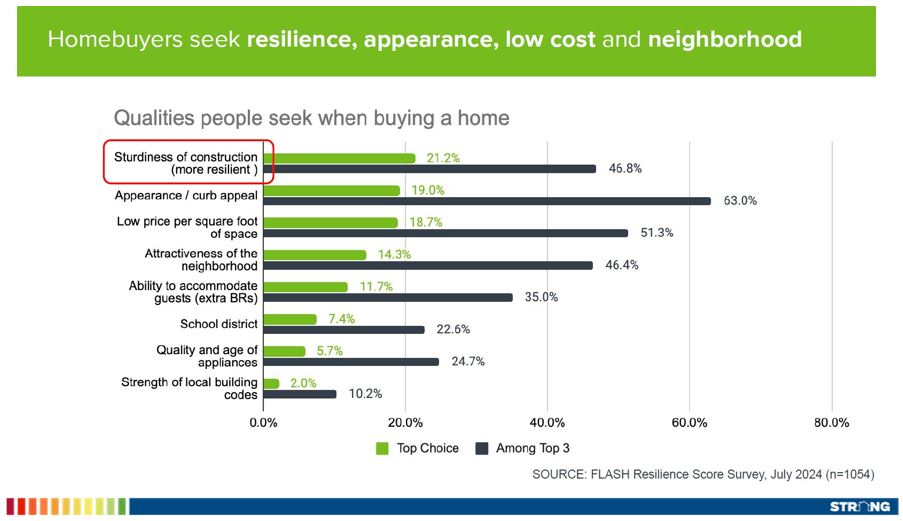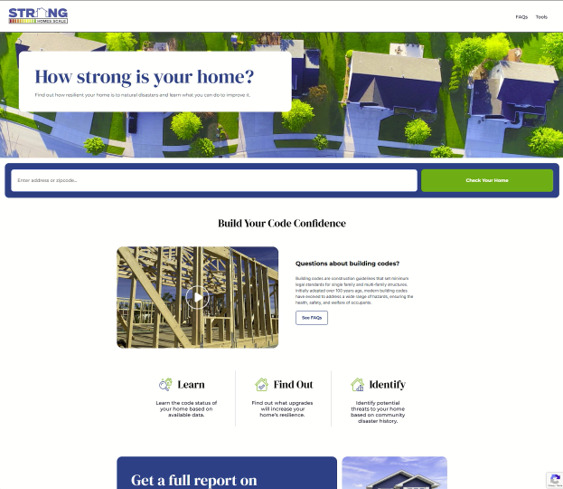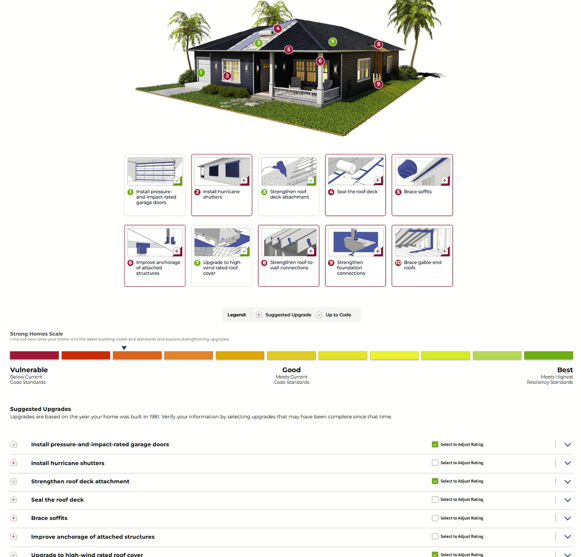
Strong Homes Scale: Connecting Consumers to Building Codes
FLASH's Strong Homes Scale indicates how close a home is to meeting or exceeding the resilience features included in the International Code Council’s 2024 International Residential Code.
A 2024 behavior-focused study confirmed what most code officials already know: many homeowners do not understand the critical role that building codes play in creating a disaster-resistant home.
This finding is part of a national effort conducted by the nonprofit Federal Alliance for Safe Homes (FLASH) to connect with homebuilders and homeowners, identify knowledge gaps and create solutions to increase building code acceptance.

Educating Communities Through the Strong Homes Scale
One of the most telling findings from the study indicated that homebuyers’ priority for “sturdiness of construction” continues to rise. However, survey respondents did not make the connection between strong building codes as the delivery system for a resilient home.
To help overcome this disconnect, FLASH and their partners created the new Strong Homes scale and added the tool to the building code transparency website, Inspect2Protect.org.

The scale indicates how close a home is to meeting or exceeding the resilience features included in the International Code Council’s 2024 International Residential Code® (IRC). This allows the users to develop a framework for understanding how well their home can withstand six major natural disasters: earthquakes, floods, hurricanes, tornadoes, wildfires and winter storms.
For each of the six hazards, there is a checklist of approximately seven to eleven key structural features that make a home resilient to each hazard, including roof-to-wall anchoring for hurricanes or foundation reinforcement for earthquakes.
How Does the Strong Homes Scale Work?
After you enter an address, the scale uses Zillow data to establish the year your home was built. It then combines the year with engineering analysis of the building code when the home was constructed and estimates which features the home likely has or lacks. In essence, it compares the building requirements in place when the home was built to a list of essential resilience features from modern codes.
These labels describe how your home compares to modern resilience benchmarks:
- Vulnerable: Indicates the home is likely below current safety standards – typical of older houses built before modern building codes or without later retrofits. These homes may lack many key protections and may be at higher risk in a disaster.
- Good: Indicates the home meets key elements of the minimum model building code relating to resilience against each of the six major disasters. A “Good” rating means the home has the core resilience features that current codes require, giving it a solid baseline of protection.
- Best: Indicates the home has the highest level of disaster resilience – it includes all major recommended features relating to each of six major disasters identified by an engineering analysis, even beyond the code requirements. This is a top-tier rating.

The presence of a feature earns a “green check” and its absence a “red X.” The combined results of all features then determine where a home falls on the rating spectrum. A home with most of the recommended features will score toward the “Best” end, whereas missing many features will push the rating toward “Vulnerable”.
The scale is dynamic, so users can check any features or upgrades completed since the original home construction and see how those upgrades move the Scale closer to “Best”.
Examples include elements like adding hurricane shutters, reroofing with an enhanced nailing pattern to resist high wind or adding attic insulation to prevent ice dams.
Other Important Features for Building Officials
Besides the scale, there are several features and tools available on Inspect2Protect.org that are valuable for building officials, including:
- Custom Building Code Lookup for IRC
- Custom Building Code Lookup for International Building Code® (IBC)
- Building Code Resilience Story Video
- Peril-Specific Retrofit Suggestions
- Comprehensive 3D and 2D Illustration Library
- Printable Checklists for Six Hazards
- Links to Technical Resources
- Disaster History Insights
- FAQ’s and Checklists
How can building officials use this new scale and other features to help consumers better understand building codes and their role? Download free promotional tools and web badges at Inspect2Protect.org, link to the site and join us on social media during Building Safety Month to help answer the question, “How Strong is My Home?”
The Code Council’s annual Building Safety Month campaign is held in May to raise awareness about building safety. Week 2, May 4 – 10, focuses on advocacy and how to create a game plan to support building safety programs in our communities. Learn more, here.





